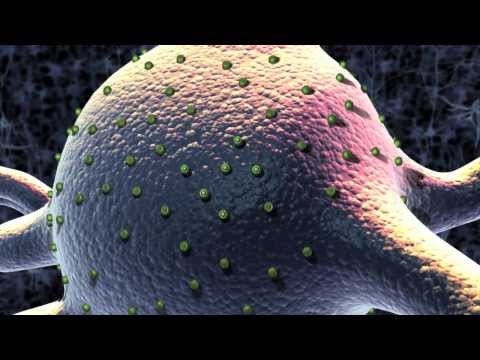The brain is made of, maybe thousands of different kinds of cells called neurons that are built into very dense, inter-mesh networks. Each of these neurons computes using electricity. The cycle implements behavior, and thought and emotion. All these different kinds of things. We also think that deficits in these electrical computations underlie many brain disorders that affect over a billion people around the world. In optogenetics, what we’re doing is we’re putting molecules, that convert light into electricity, into neurons – the cells of the brain. Then when we shine light on those neurons, light gets converted to electricity and allows us to turn on or off those cells. The goal here is to find a way to control the electrical activity in some cells and not others in the network. To do that we had to turn to the natural world. It turns out that throughout all the kingdoms of life – in plants, in funguses, and bacteria and so on – you can find photosynthetic or photo- sensory molecules that convert light into electricity.
So we borrow these molecules from nature, and then using tricks from the field of gene therapy we can put them into neurons. Now, these molecules can convert light into electricity and they do it just in the neurons that we want to control. And not all their neighbors. So we can deliver these molecules to some cells and not others and then when shine light on that network we can turn on or off that subset of the cells. If we can turn on and off a set of cells that’s embedded within within this dense matrix, we can figure out how do they contribute to a behavior. For example, if we can turn on a set of cells we can figure out what kinds of behaviors can it initiate. If we can turn off a set of cells then we can delete it momentarily, and figure out what is necessary for it. So by being able to dial in information into cells in the brain and to delete them we can to figure out how they contribute to networks and the behaviors and diseases that arise from brain computations.
We can hunt down the exact set of cells that are contributing to a specific disease state. Or, which, when activated or shut down, will remedy that disease state. That’s very important because right now a lot of drugs are developed that target molecules. But molecules are found throughout the brain. And, in fact many cells in the brain might be very molecularly similar to one another. If we can target circuits in the brain, we might be able to develop much more specific drugs. Imagine if we could hunt down the exact set cells in the brain that when activated, remedy a brain disorder.
And then if we can go in and look at the exact molecules in those cells, maybe we can find drugs that are much more specific than existing ones. You might also imagine that we can use optogenetics to directly control brain circuits in patients with brain disorders. Electricity is used to stimulate the brain in deep brain stimulation, if instead we can actually aim light at certain cells and turn them on or off, we might be much more specific. Rather than using electricity to turn on or off the cells in the brain and have many kinds of cells activated – the ones we want as well as their neighbors. If we could make just one disease associated subset, associate with light and we can turn them on or off we might be able to treat them with much more specificity.
So far optogenetics has had a lot of impact in the scientific world. But it hasn’t been used in any human patients yet. There are a couple reasons why. One is that it requires a gene therapy to deliver the gene that encodes for these light activated molecules into the body. Currently in the U.S. there are no FDA approved gene therapies. In Europe there’s just one. Another issue is that these molecules come from organisms like algae and bacteria. And so if we are putting these molecules into the body would they be detected as foreign agents and attacked by the immune system, for example. What we need is a paradigm shift in how we think about treating brain disorders. And one of our major stances is that we need new technologies if we really want to either understand the principles of treating brain disorders, you know, hunting down the exact cells in the brain that could help us treat brain disorders, or to develop new modalities, new forms of energy, new strategies for treating brain disorders by correcting the computations within the brain.
.
As found on Youtube
